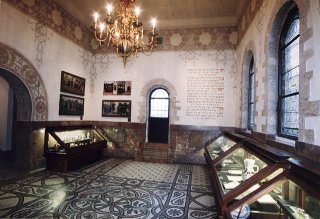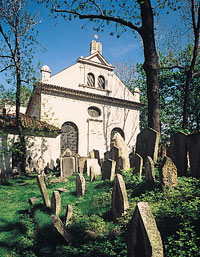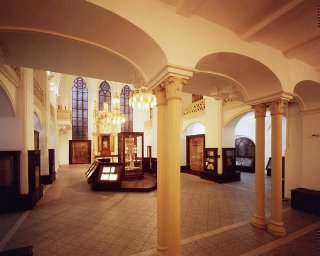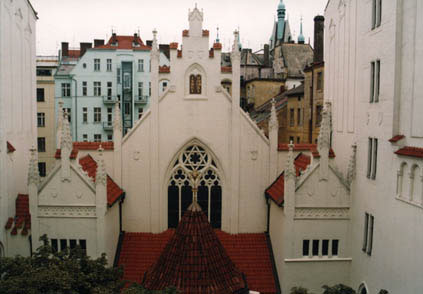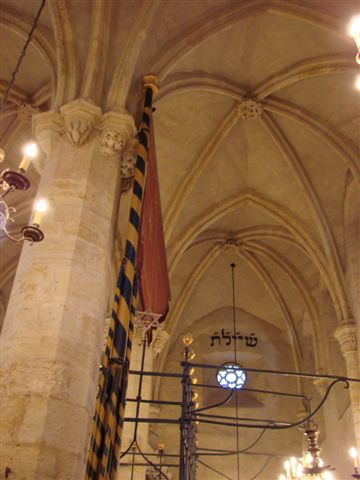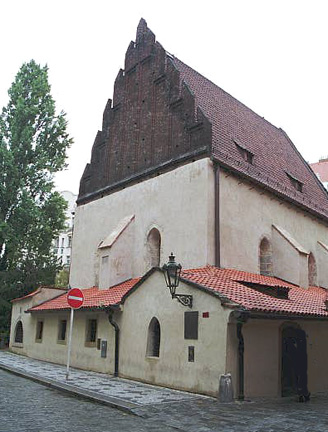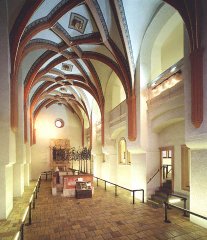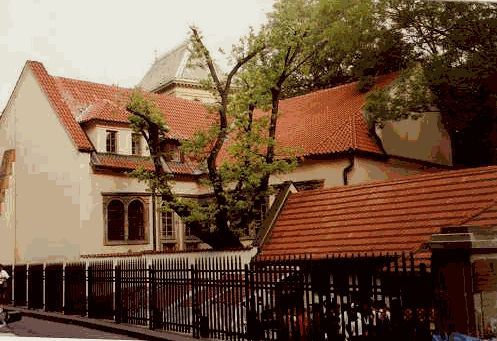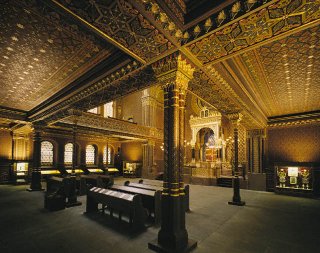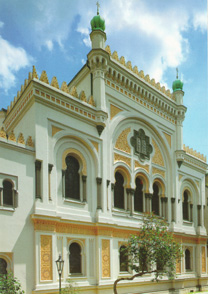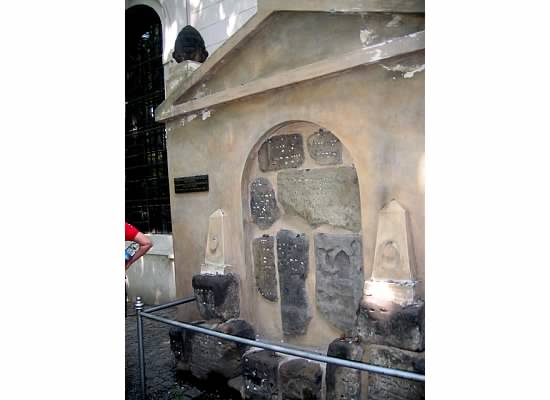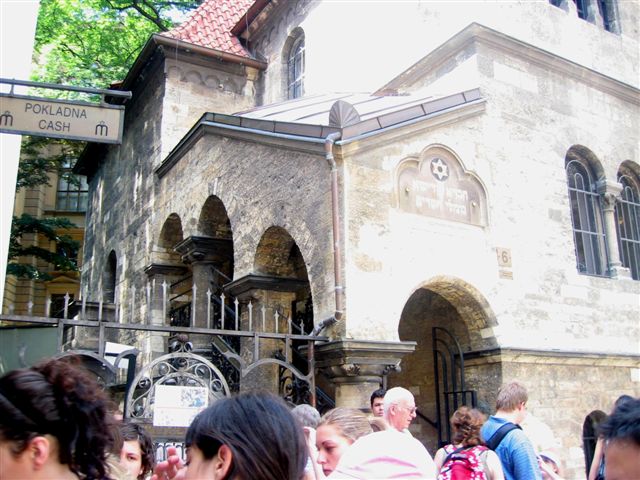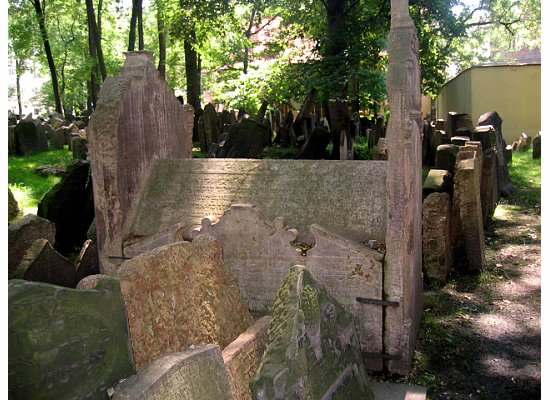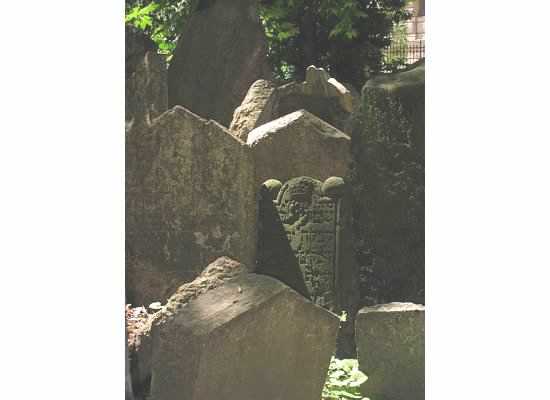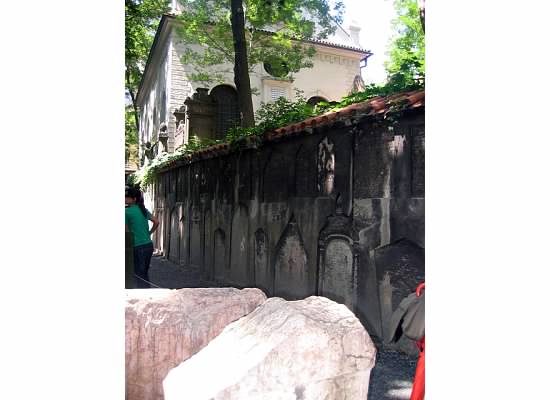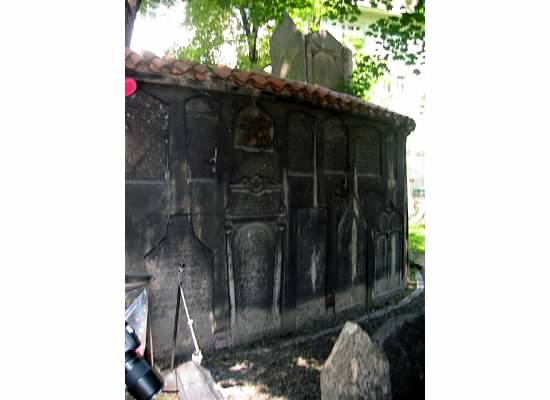Alternate names: Praha [Cz], Prague [Eng], Prag [Ger], Praga [Pol, Rus], Prog [Yid], Cheshskaya Praga. 50°05' N, 14°28' E. Capitol of Czech Republic. See District of Prague at Wikipedia to understand the administrative divisions of the city. Prague's Jewish community dates from 1091. During the siege of Prague castle in 1142, the oldest synagogue in Prague and the Jewish quarter below the castle burned. The Jews evacuated to the right bank of the river Moldau (Vltava), the future Jewish quarter and constructed the "Altschul" ("Old Synagogue") there in 1270. In the 13th century, a new Jewish settlement was founded near the Altneuschul (the "Old-New Synagogue"), still the oldest remaining in Europe. The Altschul (Old Synagogue) in Dusni Street until the 1860's was demolished. When a new synagogue was erected later, the synagogue became the "Old New Synagogue," a grayish stone structure composed of a double-naved main room for men and annexes used as a vestibule on the south and as women's areas on the north and west. The south annex of the synagogue probably is a remodeled single-naved synagogue from 1230-40, while the larger, double-naved prayer hall portion was built at the end of the 13th century. Primarily medieval, 15th century gables and late Renaissance annexes are additions due substantial restorations and renovations over the centuries. See Carole Herselle Krinsky, Synagogues of Europe, P. 169-75 for more details on the synagogue architecture. Other synagogues include the Zigeuner Synagogue named after its builder, Salkind Zigeuner and the Vinohrady Synagogue. Formerly located in the Vinohrady district of Prague and was the largest isynagogue in Prague that was badly damaged during WWII and demolished in 1951. [February 2009]
At the beginning of the 17th century about 6,000 Jews lived in Prague. By 1848, the Jewish community grew to over 10,000, one of the largest in Europe. After the Nazi takeover in Germany, the Jewish population swelled with refugees from Germany, Austria and the German speaking parts of Czechoslovakia. When the Nazis occupied Czechoslovakia in March 1939, the Jewish population was about 56,000. Until the end of 1939, some Jews were able to emigrate, legally or otherwise. In 1941, the Germans established a ghetto in the town of Terezin (Theresienstadt) -- both a concentration camp and a transit point to death camps further east. From October 1941, to March 1945, almost the entire Jewish community of Prague was deported. In the three years following WWII, the Jewish population of about 11,000 included surviving Prague Jews and other survivors of the Holocaust. Following the Communist takeover of Czechoslovakia, about half of the Jewish population emigrated by 1950. By 1968, only 2,000 Jews remained in the city. The fall of the Communist state saw the Jewish community significantly revive. [February 2009]
[UPDATE] Old Jewish Cemetery Digitization [December 2016]
- Administration office: +420 224 800 813
- Czech, English and Hebrew spoken.
- Fax: +420 222 318 664
- e-mail:This email address is being protected from spambots. You need JavaScript enabled to view it.
Virtual Jewish History of Prague with excellent photos: [February 2009]
Yizkor Books:
-
- Juedische Privatbriefe aus dem Jahre 1619
(Vienna, 1911) - Familien Prags nach den Epitaphien des alten Juedischen Friedhofs in Prag
(Pressburg, 1892)
- Juedische Privatbriefe aus dem Jahre 1619
- JOWBR burial list: Zizkov-Prague
- Synagogues Without Jews [February 2009]
(see also PRAHA listings below)
Prague cemetery pictures:
#1. [October 2000]
#2. [October 2000]
#3. [January 2002]
Old Jewish Cemetery with map. [October 2000]
#4. [January 2001]
#5 in "A photographic essay of abandoned Jewish cemeteries in Europe" by Ruth Gruber [September 2002]
cemetery photos and photos with information. [February 2009]
[UPDATE] Photos by Charles Burns [November 2017]:
|
FEBRUARY 2009: New Jewish Cemetery of Prague: The new cemetery is located at 5.5 km NE of center of Prague,in "Na malem klinu" street. (Next to metro (subway) station Želivského, green line A) The Jewish cemetery was established in 1892. Tzadakkim and other noteworthy Jews buried in the cemetery were V. Rakous. In 1890, a second Jewish cemetery was founded in Prague and opened next to the main Christian cemetery. The tomb of Franz Kafka can be found there, with a memorial stone for his three sisters, all of whom perished in the Holocaust.
Sunday to Thursday April - September 9 a.m. - 5 p.m. andOctober – March 9 a.m. - 4 p.m Friday All year 9 a.m. - 2 p.m. Closed on Saturdays and Jewish Holidays The landmarked New Jewish Cemetery founded in 1890 (5650) is the only functioning Jewish cemetery in Prague. A database can locate persons buried in individual graves and print out a detailed layout plan of the graves. The cemetery plot occupies more than 10 hectares with about 25,000 graves. see Praha-Liben Contact: Izraelská 1, 130 00, Prague 3 Telephone/fax No: +420 226 235 248 e-mail: This email address is being protected from spambots. You need JavaScript enabled to view it.
|
|
| PRAHA-JOSEFOV |
Praha - Josefov is located in Velka Praha (Greater Prague). The Old Cemetery at the center of Prague, 100 m from Old-New (Alt-Neu Synagogue in "U stareho hrbitova" street). It was also called Josefstadt; Juedische Stadt; c. Zidovske Mesto in German. Cemetery contains several layers of burials with tombstones clustered together. The oldest Jewish cemetery in Europe, open from the 15th century to the late 18th century. In 1439, Avigdor Kara was the first person to be buried here. Over the next 400 years, about 200,000 residents of the Prague ghetto were buried here. The cemetery could only hold about 10% of that amount so the tombs are layered on top of one another with one section reaching twelve layers. Two of the cemetery’s most famous tombs are Rabbi Loew (1609) and Mordechai Maisel (1601). Since 1990, the Jewish Museum of Prague has been conserving and restoring the cemetery. About 12,000 tombstones remain. See US Commission report below. [February 2009] |
| PRAHA 5 - SMICHOV |
Located at 4 km SSW of center of Prague, in "U stareko zidovskeko hrbitova" street. The Jewish cemetery was established in 1903 [?]. Tzadakkim and other noteworthy Jews buried in the cemetery were tombs of family Porges von Portheim (founders of Smichov textile industry). photo of eroded wall in overgrown Smichov cemetery. see Smichov cemetery [February 2009] [UPDATE] Wall Construction Completed [December 2016] |
| PRAHA - ZIZKOV | Located at 2.5 km ESE of center of Praha, in Fibichova Street. Tzadakkim and other noteworthy Jews buried in the cemetery were hundreds of renowned personalities famous rabbis as : Ezechiel Landau (1713-1793) and Solomon Rapaport (1790-1867). The last known Jewish burial was in 1891. see Zizkov cemetery |
| UHRINEVES (part of Prague) | Located at 1 km N, between Vachkova Str. and Vbytovkach Str. It was also called Aurinowes; Aurschinewes in German. Uhrineves is 14 km SE of centre of Prague.The earliest known Jewish community in this town was early 18th century. The Jewish population was 55 people in 1930. This Jewish cemetery was established in early 18th century. The last known Jewish burial was in probably about 1946. see Praha-Uhrineves |
| "Old Olsany cemetery in Prague-Zizkov" |
e-mail from: "Schoenberg, E. Randol" , 28 Jan 2000 Photos: February 2009 |
Cemetery of Noda B’Yehuda |
(Next to metro (subway) station Jiřího z Poděbrad, green line A). Open: Tuesday and Thursday from 9 am - 1 pm
|
Starý židovský hřbitov/Old Jewish Cemetery:
- Established in the first half of the 15th century aong with the Old-New Synagogue and one of the most important historic sites in Prague´s Jewish Town, the oldest tombstone [grave of the poet and scholar Avigdor Karo] dates from 1439. Burials took place in the cemetery until 1787 with some 12,000 tombstones for a far greater number of persons buried here. Enlarged a number of times in the past, the area did not suffice so earth was brought in to add layers so that the cemetery contains several burial layers, one on top of another. Thus, picturesque tombstones group together from various periods as older stones rise to the upper layers. Burial place of illustrious Rabbi Judah Loew ben Bezalel (d. 1609); mayor of Jewish town, Mordechai Maisel (d. 1601); Renaissance scholar, historian, mathematician and astronomer David Gans (d. 1613); scholar and historian Joseph Solomon Delmedigo (d. 1655); and rabbi and bibliophile, David Oppenheim(d. 1736).
US Commission No. CZCE000384
Alternate name: Josefstadt; Juedische Stadt; c. Zidovske Mesto in German, English, Prague. Praha-Josefov is located in Bohemia-Velka Praha (Greater Prague) at 5005 1428. Cemetery is located in center of Prague, 100 m from Old-New (Alt-Neu) Synagogue in "U Stareho Hrbitova" Street. Present town population is over 100,000 with 1,000-10,000 Jews.
- Town: Obvodni Urad, Mayor: Ivan Spevak, Vodickova 18, 110 01 Praha 1; tel. 02/20-49-51, fax: 02/20-64-01 and Magistratni urad, Mayor: Milan Kondr, Marianske namesti 2, 110 01 Praha 1; tel. 02/283-11-11, fax: 232-68-02.
- Regional: Prazska ZNO, Maislova 18, 110 01 Praha 1; tel. 02/231-06-34 and
- Interested: Statni Zidovske Muzeum, Jachymova 3, 110 01 Praha 1 tel. 02/231-06-34 or 341-07-85.
- Key-holder and caretaker: Statni Zidovske Muzeum (see above)
Earliest known Jewish community was 11th century. 1930 Jewish population was 35,425. Pogroms occurred in 1142, 1389 as did many big fires. Jewish community temporarily was banished in 1543-1545, 1557, 1745-1748. Increase of Jewish population occurred until Nazi occupation (54,500 persons subject to racial laws in 1940). After Holocaust, aliyah occurred. Today, Prague is the seat of both Prague Jewish congregation and Federation of Jewish Communities in the Czech Republic. The landmarked Orthodox Jewish cemetery originated in first half of the 15th century as the third cemetery of Prague. Buried in the cemetery are poet Avigdor Karo (d., 1439, oldest legible tombstone in cemetery), Chief Rabbi and philosopher Yehudah ben Bezalel Liva-Loew (d. 1609), and Rabbi David Oppenheim (1664-1736) with last known Jewish burial in 1787.
The flat urban separate site has Czech and Hebrew signs or plaques, inscriptions in Hebrew on gate or wall, Hebrew inscriptions on pre-burial house, and Jewish symbols on gate or wall. The marker mentions famous individuals buried in cemetery and the Chevra Kadisha. Reached by turning directly off a public road, access is open via admission fee during hours of operation. A continuous masonry wall and locking gate surround. The pre- and post-WWII size of cemetery is 0.99 ha. Approximately 12,000 stones date from 1346 (transferred from older cemetery) and legible: 1439 (original in this cemetery from 18th century). The marble, limestone and sandstone tombstones are flat shaped stones, flat stones with carved relief decoration, and tombs with Hebrew inscriptions. The cemetery has special sections but no known mass graves. Within the limits is a pre-burial house with wall inscriptions and a chimney protected for its architectural value and a synagogue. Praha Jewish community owns Jewish cemetery. Properties adjacent are commercial or industrial, residential, and museum.
Organized Jewish group or individual tours or pilgrimage groups, and private visitors visit frequently. Vandalism reduced site by 0.2 ha s in 1903. Local/municipal authorities, regional/national authorities and Jewish groups within country did restoration continuously after WWII. Praha Jewish congregation pays the regular caretaker. Vandalism is a moderate threat: In conjunction with the cemetery is Pinchas Synagogue with inscription of 77,770 names of Czech and Moravian Jews who perished during WWII, a very good source of information if you are looking for data on area residents who perished during WWII.
"In Prague, the Jewish cemetery has bodies buried 12 deep. There are about 12,000 gravestones in a very small area. Our tour guide was Sylvia Wittmanova from Wittman Tours, the Jewish tourist agency in Prague." Source: This email address is being protected from spambots. You need JavaScript enabled to view it.
REFERENCES:
- Alterhuemer der Prager Josefstadt israelitischer Friedhof, Alt-Neu Schule und andere Synagogen (The old Jewish cemetery, Alt-Neu Schule and other synagogues in Prague Josefstadt (ghetto) by D. Podiebrad. Two of these are 1. Prague, 1855. 71 pages, illustrated, German. 29V4846. Notes: 10 tombstones, 66-1770, tombstone photographs 2. Prague, 1870. 166 pages, illustrated. 61B1928. Notes: 14 tombstones, 66-1770. Prague Burial Society history, Salomon Molho biography, Avigdor Karo elegy.
- Andenken an den alten israelitscher Friedhof und seine Umgebung in Prag (In memory of the old Jewish cemetery in Prague and its neighborhoods), by D. Podiebrad. Prague, no date. 2 pages, illustrated, German. L1880. Notes: 7 tombstones, 1439-1770, photograph only. Antiquitates judaicae pragenses; jurze erlaeuternde Notizen (Jewish antiques in Prague; short explanatory notes), Prague, 1900. 13 pages, German & Latin title. s77B1722. Notes: 18 tombstones, 1476-1787, Rabbis short biographies.
- Der alte juedische Friedhin Prag (The old Jewish cemetery in Prague), by the Prague Zidovske museum. Prague, 1966. 39 pages, illustrated, German. 71B1620. Notes: 11 tombstones, 16 persons + one tombstone, 14 century-1655 & 1903, art analyses.
- Der alte Judenfriedhof Prag (The old Jewish cemetery in Prague). Prague, 192?. 12 pages, German. 29V4821. Notes: 13 names and biographies, 1439-1613.
- Der alte Prager juedische Friedhof (The old Jewish cemetery of Prague), by A. Kohut. Prague, 1897. 112 pages, Gothic German. 29V4837. Notes: 170 inscriptions, 13th century-1712. Names are included in the text so it is impossible to know how many persons are mentioned; special chapter for women, cemetery history, Prague Jewish history.
- Die Inschriften des alten Prager Judenfriedhofes (The inscriptions in the old Jewish cemetery in Prague), by L. M. Popper and W. M. Popper. Braunschweig 1893. 42 pages, Gothic German and Hebrew inscriptions. 29V4849. Notes: 170 names, 1618-1785 (1-1546), non-alphabetical order by professions or nicknames, no index.
- Gal-Ed. Grabsteininschriften des prager isr, alten Friedshofs mit biographischen Notizen (Prague old Jewish cemetery Epitaphs, added biographical notes); by Liebsn, Koppelmann (Kaloan); Prague, 1856. [226] p. (German & Hebrew); Notes: Period: 941-1787. 170 tbsts. German index of personal names.
- Ktovot mibeit ha'almin hayehudi ha'atik beprag (Epitaphs of the old Jewish cemetery in Prague), by O. Muneles. Jerusalem, 1988. 501 pages, illustrated, Hebrew and English title page & contents. S88A2184. Notes: 247 tombstones, 1444-1877, biographical notes in Latin and Czech, names index, index of persons mentioned in inscriptions, index of outstanding persons and tombstone location, index of personal names, bibliography.
- Old Prague Jewish cemetery, Photographieni Jan Lukas; by Jindrich Lion; Published: Praha Artia, 1960. Title and text in German, English and French. 325.25693 L954 Staronova Synagoga a Stary Zidovsky Hrbitov. Herman, Jan. Praha: Obelisk, c1972. [15]p. col. plates. 40cm. Cover title. Text in Czech, Russian, French, German and English. ID # f GT 3248 P7 H47 [Leo Baeck Institute]
- Stary zidovsky Hrbitov v Praze (The old Jewish cemetery in Prague), by O. Muneles and M. Vilimkova. Prague, 1955. 480,39 pages, Czech and Hebrew inscriptions. 56B1390. Notes: 170 tombstones, 1434-1588, men and women, inscription analysis, general index. The old Jewish cemetery of Prague: a guide through the cemetery and a selection of its most important memorial from the XIVth-XIXth centuries, by the Prague Zidovske museum Prague, 1947. 15,40 pages, plates, illustrations, map. 50B908. Notes: 36 tombstones list, 1349-1769, tombstone photographs (some readable), and cemetery history.
- L954 Staronova Synagoga a Stary Zidovsky Hrbitov. Herman, Jan. Praha: Obelisk, c1972. [15]p. col. plates. 40cm. Cover title. Text in Czech, Russian, French, German and English. ID # f GT 3248 P7 H47 [ Leo Baeck Institute]
- Stary zidovsk H bitov v Praze (The old Jewish cemetery in Prague), by O. Muneles and M. Vilimkova. Prague, 1955. 480,39 pages, Czech and Hebrew inscriptions. 56B1390. Notes: 170 tombstones, 1434-1588, men and women, inscription analysis, general index. The old Jewish cemetery of Prague: a guide through the cemetery and a selection of its most important memorial from the XIVth-XIXth centuries, by the Prague Zidovske museum Prague, 1947. 15,40 pages, plates, illustrations, map. 50B908. Notes: 36 tombstones list, 1349-1769, tombstone photographs (some readable), cemetery history.
- Leo Baeck Institute materials:
Cemetery list donated by H. Jacobson: Leo Baeck Institute, 1969: Finding Aids: 39-page inventory; Period covered (or date of publication): 1660-1958; Size of the collection: 18 feet 37 reels. Leo Baeck Institute Location: Jacob Jacobson collection; Storage-Cemetery: V 8/1-8, 2nd floor left microfilm cabinet Accession Number(s): AR 7002, MF 134(2), MF 447, 1-37. - Der alte Judenfriedhof Prag. Praha: Kollmann, Ludwig Verlag der Israelitischen Beerdigungs-Bruederschaft, 191-? 9p. illus. 18cm. ID # GT 3248 P7 K65. Hebrew College Library in Brookline, MA:
- Der Alte Prager Judenfriedhof (The old Jewish Cemetery of Prague). Dr. L. Jerabek, Prague, 1903. 47 p. + illus.
- Die Familien Prags. [Epitaphein des Alten Juedische Friedhofs in Prag] [Prague families: Epitaphs of the old Jewish Cemetery in Prague; Simon Hock, David Kaufmann, Pressburg, 1892 (402+36p, in German and Hebrew (22,000 tombstone inscriptions, 9th-19th centuries)
OTHER BOOKS: - Tanu ez a Kohalom (This Cairn is Witness Today), a very interesting book of Jewish Cemetery Photographs, published in Hungary in 1993 by Saros Laszlo and Vali Dezso. ISBN 963 7476 172. The cemeteries contained and the number of photographs of each is listed. The vast majority of this 149-page book contains black and white photographs with 8 pages of (English text) general information. Sections are Introduction, Cemetery in Ancient Times, Old Tombstones, Cemetery and History, The Tombs of the Ancestors, Tent and Parchment, People and Flower, Rituals of Death, Epitaphs, Signs and Symbols I. Symbols II. Animal and Vegetal (sic) Symbols III. Hebrew Abbreviations Bibliographical Notes 11 pictures of Prague. picture
Source of the following is Jewish Museum of Belgium and This email address is being protected from spambots. You need JavaScript enabled to view it.:
- "The Topographics of the Pictujournal, review Collection of the State Jewish Museum. II. The Old Jewish exhibition catelogmetery in Prague in the Pictujournal, review s of Romantic articletists of the 19th exhibition catelogntury ", 358, article p.000359, 6/19/1990, ParticleI Karno, title: "in Judaica Bohemiae, Volume XIX/2", Judaica Bohemiae, 1983, pp. 99-111, ANG
- Der Alte Juedische Friedhin Prag, 1010, book 000084, 1/5/1983
- HERMAN Jan, title:... Das Staatbookche Juedische Museum in Prag, 1966, 39 p., German
- Jakobovits Tobias, title: Ein Fuehrer durch den Friedhof und seine wichtigsten Denkwuerdigkeiten aus dem XIV-XIX Jahrhundert, Das Staatbookche Juedische Museum in Prag, 1960, 22 p., German
- The Old Jewish exhibition catelogmetery of Prague. Volume III,1121, book 000196, 1/11/1983, Volavkova Hana, title: A guide through the exhibition catelogmetery and a selection of its most important memorials of the XIVth-XIXth century, The Jewish Museum of Prague, 1947, 15 p., English, "Nouveau Cimetièjournal, review Juif de Prague-Monument Cultujournal, review l Protégé",237, article p.000237, 6/15/1990, KAFKA Frantisek, title: "in Judaica Bohemiae, Volume XXIII/2", Judaica Bohemiae, 1987, pp. 101-113, F,
- "Prague cemetery was not large enough to accommodate Prague Jewry, so new graves were piled on the old after the cemetery "closed" in 1737. The oldest preserved tombstone is that of the scholar and poet Avigdor Karo, who died April 25, 1439. Other identifiable tombstones include Rabbi Loew (Yehuda Levi Ben Bezalel, also know as the Maharal); David Gans, a Renaissance astronomer (1613); and Mordechai Maisel, mayor of Prague Jewish community from 1528 to 1601." Source: Freedman, Warren. World Guide for the Jewish Traveler. NY: E.P. Dutton Inc, 1984.
Photos courtesy This email address is being protected from spambots. You need JavaScript enabled to view it. , 2006


